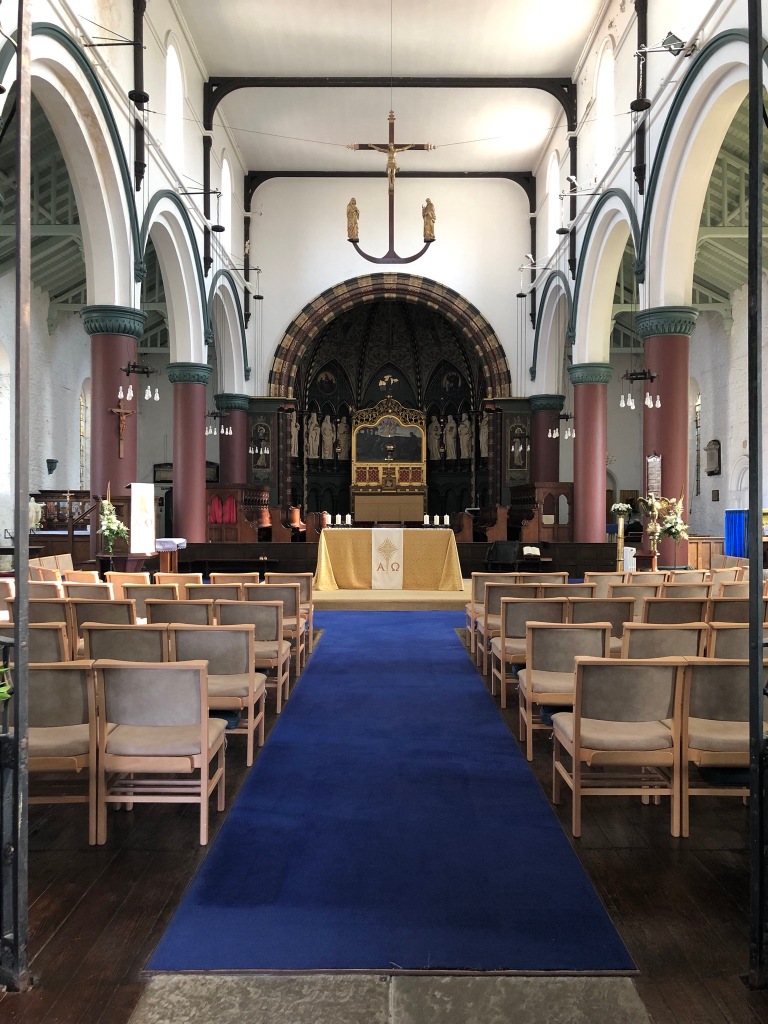Straying saints and fast cities
This screen seems solid, unmoveable, part of the fabric of the building. Yet it came from another church building now long gone, the former church of St Dyfrig. The church stood on Wood Street in an area of Cardiff once known as Temperance Town near Central Railway Station before the city quickly moved on. It’s this screen – and its straying figures of Jesus, Mary and John – that we’re taking as our seventh article of faith.
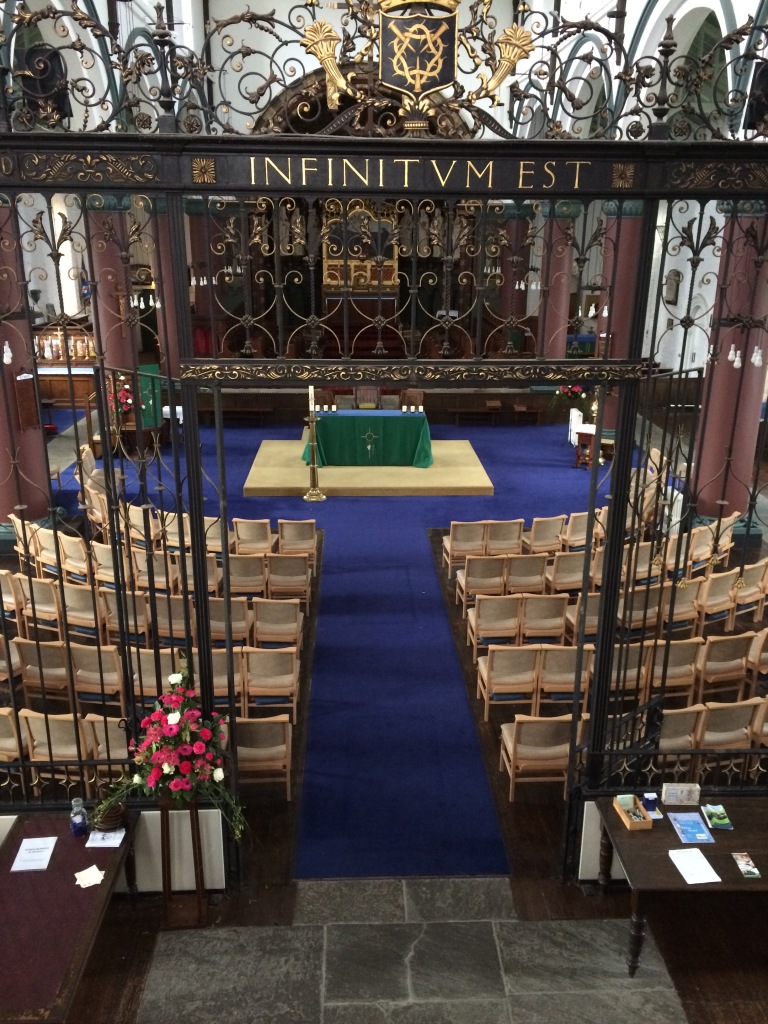
Keeping up with the pace
Hidden away in our archives are sixteen letters written, during the first half of the 1970s, by the famous church architect, George Pace. They were sent to two successive Vicars of St Mary’s, Fr Gillingham (who had left Cardiff for what Pace, obviously quoting Fr Gillingham, describes as a “rather rundown parish”) and his successor, Fr Oman.
The last few letters are silent of his signature. Pace died in August 1975 and failed to see the completion of the particular work in hand although his initial plans were slightly more extensive than they turned out to be.
In the years after the Second Vatican Council (1962-65) many church buildings were reshaped and reimagined. St Mary’s was no different as it rode the wave of a liturgical revival, keeping up with the pace of renewal.
But back to the first hand written note. “The screen from S. Dyfrig’s Church now stood at S Samsons would be excellent re-erected near the west end of the nave at S. Mary’s,” writes Pace. “Could you have a word with the Vicar of S Samson’s about getting the parts of the screen to St Mary’s and storing in the N. aisle?’
But what of St Dyfrig’s Church?
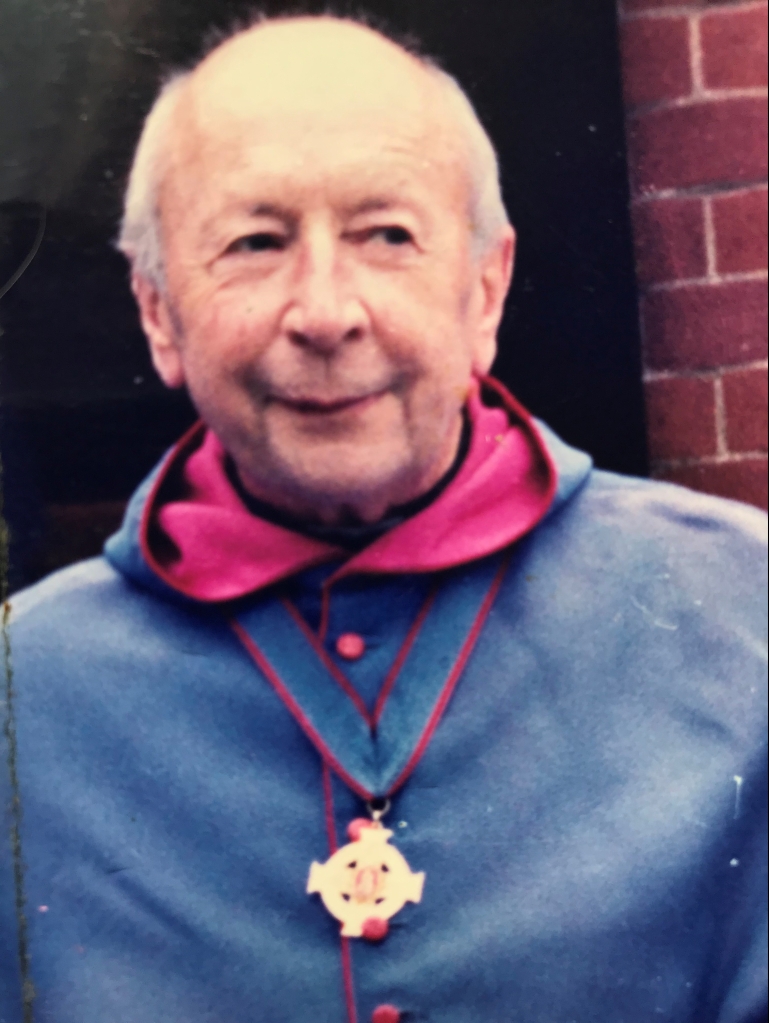
The shape of a city
Cities grow up and out, extending their reach and embracing neighbouring communities. Capital cities like Cardiff compete with others for investment and events, try to make their way in the world, to stand tall, stand proud, create prosperity and yet often, too, widen the unwieldy gap between rich and poor.
Times change and these poorer communities, once overlooked, ignored and derided may suddenly gain the interest of developers who see new value on the land, if not on the people who live there.
This was the case, perhaps, with Temperance Town, first fashioned in 1833 but, by 1937, an embarrassment to Cardiff Corporation and an opportunity for Developers to move out people, pull down houses, demolish buildings, and clear the land for a new imagined landscape.

Since that first redevelopment, this small area of Cardiff has received several reinventions, and is being developed still with new buildings shouldering up to the Principality Stadium, like the stout BBC Studios and several steel-spined buildings forming Central Square and the new smiling face of the Tax Office with the ground nearby giving way to the long awaited Transport Hub. Things move on.
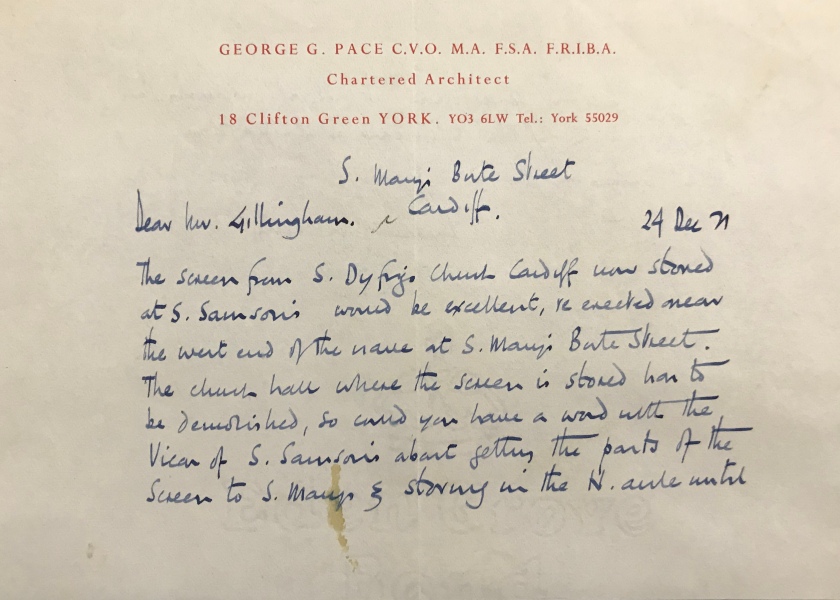
‘We sit round and finish it together’
Initially, Temperance Town was built on land owned by Colonel Wood, a teetotaller, who stipulated that the new community would be free from pubs and beer sellers.
The first Temperance Society in Cardiff was established in 1833 which not so much advocated complete prohibition from alcohol but moderation although many people signed a ‘Temperance Pledge’ promising to abstain from intoxicating drinks, their framed certificates hanging proudly in their homes.
The Movement was closely linked to Non-Conformist chapels whilst many industrialists supported the idea too, tired of ‘worse for wear’ workers or those who didn’t turn up to work at all, especially on Monday morning. The Sunday Closing Act for Wales ceased Sunday trading altogether but the consequential dangers were illicit drinking dens, a criminal subculture and excessive drinking at home.
It was for this reason that the Vicar the time, Fr Jones, lamented the Act “which increased rather than diminished the harm it was intended to avert.”
One day, he asked a working-man how he managed to get a glass of beer on Sunday if he wanted one. The man replied, “Oh, I and my pals have a cask in on Saturday. The first Sunday I had a glass in the morning and went for a walk: when I came back my pals had finished the cask. So now we manage better: we sit round and finish it together.”
Whilst he refused the belief that drinkers were sinful, and the abstinent were on the way to perfection, one frequently finds in his diary entries to this effect: “Administered the pledge to a man.” “Two women came to take the pledge.” He knew that total abstinence was the only hope for “slaves of drink” but, for those who wished to drink, he simply advised moderation.
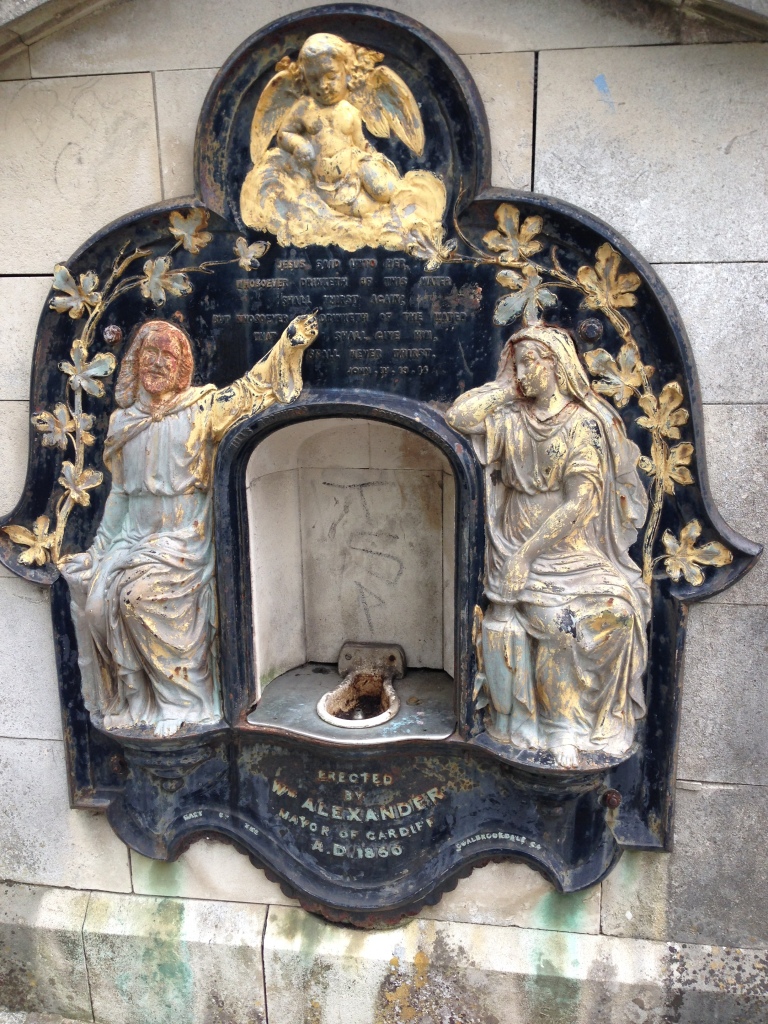
‘The great unwieldy parish’
St Mary’s Mission in Temperance Town began soon after Fr Griffith Arthur Jones arrived in 1872, as each of the clergy took responsibility for different parts of the parish.
One of his first curates, Rev. W. H. Kirby, wrote that he “first made the acquaintance of Father Jones, or Father Arthur, as his friends loved to call him, in the Lent of 1872, just after he had left his beloved parish of Llanegryn to become the vicar of the great unwieldy parish of S. Mary’s, Cardiff, with its population of 25,000 of all conditions and nationalities.”
“After spending a day or two with him at 52, Loudoun Square, which with the adjoining house afterwards became the Clergy House, I decided to come and work with him, first as a layman, being subsequently ordained deacon in September 1872, and priest in September 1873, in Llandaff Cathedral, by Bishop Ollivant.”
“I joined Father Jones at Cardiff soon after Easter, and had as my special charge Temperance Town … where an upstairs room in a house in Park Street used in the daytime as a private school, formed the nucleus of what was known for a time as the Mission of the Good Shepherd.”
Shortly after Kirby left the parish in 1875 the room had to be given up, and it wasn’t until the following spring that services resumed, taking place in a school-chapel built on ground given for a day school by the Marquis of Bute with the agreement that it would be available for Church Services.
Land Dispute
The new Mission opened on 26 April 26, 1876 with a sermon preached by Rev. S. E. Gladstone, Rector of Hawarden, who came to Cardiff straight from the dedication of the Chapel of Keble College, Oxford, which eventually obtained the patronage of S. Dyfrig’s Church that was to come. On this occasion, the Vicar announced that he looked forward to building a permanent church.
Ground had already been purchased but there was a counter claim for the land by the Cardiff School Board. He promised the claim would be resisted as it was the only piece of land that the Church could obtain in that district.
In the dispute with the Board, the Vicar was partially successful, retaining just part of the land which meant that St Dyfrig’s covered every inch of the ground possessed by the Church, tightly adjoined by the school. But we’re moving on too quickly!
The Face of Coe
Before the church could be built, funding was needed. On 28th December 1887, Fr Hector Coe, the Curate who joined the parish in 1875 and had taken over Kirby’s work in Temperance Town, made an appeal for donations in the local press.
The initial design of the Church was far more grand and expensive than anticipated by the Curate. The drawings were tweaked bringing the price down to £3,707
The architect was John Sedding, who had also redesigned and redecorated the apse at St Mary’s with life size statues (by C.W. Seale) of the 12 Apostles, one of whom has the face of Coe himself!

Flags and Coronets
In 1888, the Memorial Stone of the new Church of S. Dyfrig’s Church was laid. The Bishop preached to a crowded congregation in the Mission Chapel followed by a procession along Wood Street.
The clergy and congregation sang the Litany of the Holy Ghost along the way with “Mr. W. Sullivan and a friend accompanying on cornets.” Fascinated residents looked on and “the neighbourhood was brilliant with flags.”
Free from debt
The church was consecrated on Tuesday 14 November 1893. “The church which is still incomplete,” read the South Wales Daily News, “consists of chancel and two bays of the nave, accommodates 450 worshippers, and is quite free from debt. Money, however, is needed for the endowment of the new ecclesiastical parish of St Dyfrig proposed to be formed.”
Two years later this happened and, on 29 May 1895, Hector Coe became its Vicar. The second stage of work to complete the building began in 1904. Fr Coe continued in post until 1921.
In the spring of 1897, a third Mission began in a part of the parish adjoining St Paul’s, Grangetown, in a street leading off Penarth Road in a room above a bakehouse. A few years later, on the other side of the road, St Samson’s Church was opened. But that’s another story.

The pace of a city
By the late 1930s, Temperance Town was termed a slum, and developers saw its potential. Houses and building were pulled down. St Dyfrig’s followed their demise in 1969.
The hand carved Stations of the Cross and the Reredos of the Adoration of the Magi made their way to St Samson’s Church as did the name of Dyfrig. The Chancel screen, six years later, came to St Mary’s.
The Screen for some years was stored in St Samson’s Church Hall and, now that it was due to be demolished, plans were put in place to move the screen to St Mary’s Church under the eye of George Pace.
The rood figures of the crucified Christ, the Blessed Virgin Mary and the Beloved Disciple which stood on top of the screen were crafted into an anchor-shaped cross and, after first being situated behind the Nave Altar, was eventually hung high above. Pace’s plan had been to remove the choir stalls to the west end of the church and use the cleared space for a new nave altar. This never happened.
What we do have, however, is a space that is both open and intimate, a bright and light place that naturally gathers people around the altar to celebrate the Eucharist in a way that reflects Henri Nouwen’s description of that Sacrament as being “the most human and divine gesture imaginable.”
We have plans to develop the building further as each generation glimpses new possibilities whilst retaining the importance of who we are.
There is no losing sight of the Lord’s Table as we minister to an unwieldy world, and try to keep up with the pace of a city which is constantly changing and reshaping itself.
